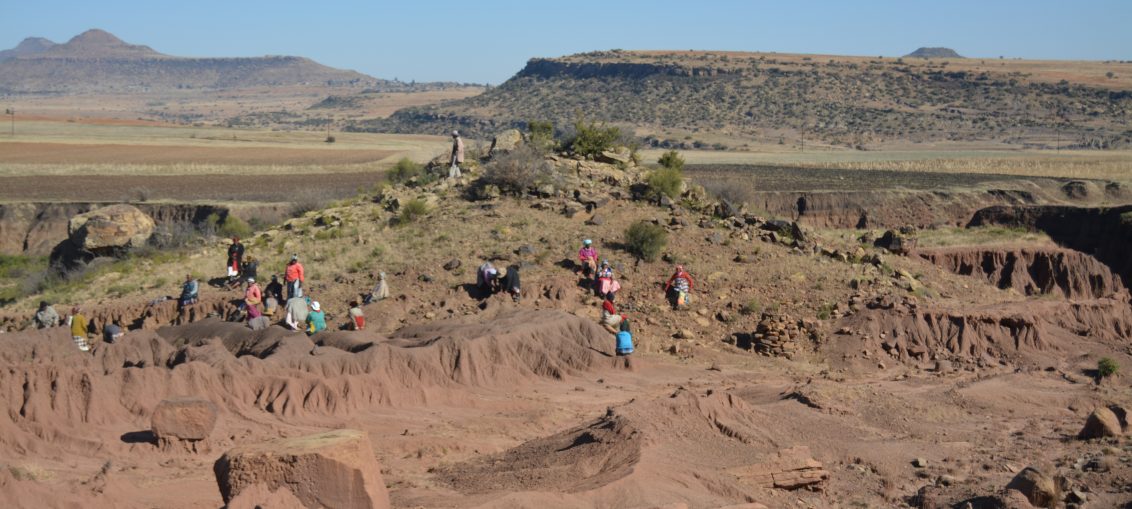
By Olivia Konotey
MOHALE’S-HOEK – The village of Ha-Khitšane is built on sand. In the approaching warmth of Spring, daffodils push themselves out of the ground amongst patches of parched grass.
In the ground behind her house, ‘Mamonaheng Belete is planting peach trees. It is a way of restoring land which storms and drought have worn away over the decades.
Scribbled across the land surrounding the village are dongas, deep gullies spread across much of Lesotho, which render the ground unusable for agriculture. Encircled by South Africa, Lesotho is a country of mountains and waterfalls.
Seventy percent of the country’s population live in the countryside, raising livestock and home vegetable gardens, planting maize, wheat and corn.
World Bank reported Lesotho’s agricultural land to be at 75 percent in 2014, and this land steadily continues deteriorating with climate change causing floods and drought increasingly common.
In 2015, El-Niño phenomenon swept across the Southern region of Africa, wreaking havoc with usual weather patterns and the livelihoods of farmers. In Lesotho, the government had declared a state of emergency as the drought attacked land and crops.
In 2013, the World Food Programme (WFP) became partners with the government of Lesotho for the latter’s Fato-Fato (community development) programme – an initiative which paid rural people in food or cash in return for their work to halt or reverse the land degradation overtaking much of the countryside.
Ideally, to take part in the Fato-Fato, villagers come together to select the most vulnerable members of their community to work on the project.
At Ha-Khitšane, widows who were raising children and grandchildren were among those selected. With the cash amounting to M1200 she received, each could buy food for the family, pay school fees and clothes for all members.

Belete’s husband became ill after years of mining and died five years after returning to the village. She lives with her son whilst her daughter looks for work in South Africa.
Belete looks after her daughter’s three children, who go to the local primary school. She has been working on a WFP programme, Food Assistance for Assets (FFA).
For the past four months FFA beneficiaries in Mohale’s Hoek have not received any humanitarian assistance due to funding challenges that the WFP faces.
The structures they had made to protect the land deteriorated as the country experienced crop failures for the two years following the El-Níno.
In 2017, the WFP revived the projects in the areas of Lesotho’s most vulnerable to hunger after El Níno.
Participants would work on a voluntary basis, and Belete has been working on the programme since then. “We cope…”, she explains, “…everyone here finds ways to cope.”
Patrick Oliphant, the WFP field officer monitoring the FFA project, explains, “this area has been praying for rain. There are no crops around this village because it’s been one of the worst hit by drought.”
In December 2017, the village tried to plant maize but due to late rains, the crop failed.
Roughly once a week, Belete goes to the work site, about an hour’s walk from the village.
Together with other vulnerable villagers, they collect rocks which the men use to build the stone lines to trap water and falling rocks and soil, preventing the ground from sliding away and trapping water to saturate the now-parched soil.
Everything is quiet except for the murmur of voices, punctuated by the sharp sound of a pickaxe repeatedly being buried in the ground, preparing the ground to plant fruit trees.
Almost invisible in the dust and rocky mountainside, lays lines of stone snakes across the slopes.
Working on the ground, Belete explains, has been a chance to escape from the constant worry of how to provide for her family. “When I’m at work, it keeps the mind busy,” She says.
They are seeing the results of their labour. Grass is now growing again after years of failure, which can feed animals or be collected for rondavels – thatch-roofed buildings common particularly in the rural sides of Lesotho.
Belete says she is hopeful for the future of their village. “We’re willing to do what’s necessary for the land,” she says and adds, “the whole village is unified for this. I promise, we will look after what’s ours.”
